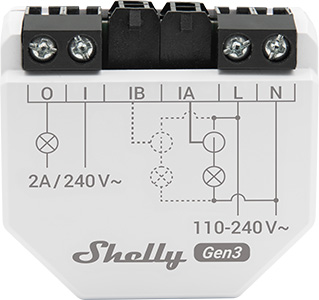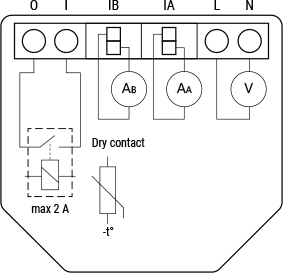Shelly EM Gen3

Device Identification
- Device name: Shelly EM Gen3
- Device model: S3EM-002CXCEU
- Device SSID: ShellyEMG3-XXXXXXXXXXXX
- BLE Model ID: 0x1027
Short Description
The Shelly EM Gen3 is a compact smart energy meter that uses up to two current transformers (non-contact measurement) to monitor the power consumption of electrical appliances. It reports data to mobile phones, tablets, PCs, or home automation systems and can operate either standalone on a local Wi-Fi network or via cloud-based home automation services. The device features internal storage for up to 10 days of minute-resolution data logs.
It includes a single dry contact relay for controlling external loads and supports remote access, control, and monitoring from anywhere with internet connectivity—provided the device remains connected to a Wi-Fi access point.
The Shelly EM Gen3 is designed for retrofit installation in standard electrical wall boxes, behind power outlets, light switches, or other space-constrained locations.
An embedded web interface enables users to monitor, configure, and control the device directly through a browser.
Main Features
- Compact form factor
- Single-phase, dual-channel power measurement
- Current transformer inputs for non-contact sensing
- Dry contact relay for load control
- Real-time clock (RTC)
- Local data logging: up to 10 days of 1-minute resolution records
Use Cases
- Power Consumption Monitoring: Track real-time energy usage of connected devices to understand consumption patterns and identify inefficiencies.
- Energy Efficiency Optimization: Analyze usage trends and optimize electricity consumption accordingly.
- Appliance Health Check: Monitor long-term power draw to detect anomalies—sudden spikes may indicate equipment issues.
- Cost Management: Estimate running costs per device to better manage electricity expenses.
- Space-Efficient Retrofitting: Easily install in standard wall boxes, behind sockets, or in tight spaces.
- Remote Monitoring: Publish data to Shelly Cloud or third-party cloud platforms for off-site monitoring.
- Local Monitoring & Automation: Operate independently using local rules based on instantaneous power or cumulative energy over time—no cloud required.
Main Applications
- Residential
- Multi-Dwelling Units (MDUs): apartments, condominiums, hotels
- Light Commercial: small offices, retail stores, restaurants, gas stations
- Government / Municipal facilities
- Educational institutions (universities, colleges)
- Farming and agricultural operations
Simplified Internal Schematics

Connectivity
- Wi-Fi
- Bluetooth
Protocols
- MQTT
- HTTP
- WebSocket
- RPC
Safety Function
- Internal temperature sensing and reporting
Supported Load Types
- Resistive (incandescent bulbs, heating elements)
- Capacitive (LED drivers, capacitor banks, electronic equipment, motor start capacitors)
- Inductive (transformers, fans, refrigerators, air conditioners)
User Interface
Inputs
- One (Control) Button
- Press and hold for 5 seconds: Enable device access point and Bluetooth.
- Press and hold for 10 seconds: Factory reset the device.
Outputs
- LED (Monochrome Indicator)
- AP enabled, Wi-Fi disabled: 1 sec ON / 1 sec OFF
- Wi-Fi enabled but not connected: 1 sec ON / 3 sec OFF
- Connected to Wi-Fi network: Constantly ON
- Cloud enabled but not connected: 1 sec ON / 5 sec OFF
- Connected to Shelly Cloud: Constantly ON
- OTA (Over-the-Air) update in progress: 0.5 sec ON / 0.5 sec OFF
- Button pressed and held for 5 seconds: 0.5 sec ON / 0.5 sec OFF
- Button pressed and held for 10 seconds: 0.25 sec ON / 0.25 sec OFF
Note: LED states are prioritized in order listed. Higher-priority states override lower ones.
Specifications
| Category | Parameter | Value |
|---|---|---|
| Physical | Size (H×W×D) | 37 × 42 × 16 mm / 1.46 × 1.65 × 0.63 in |
| Weight | - EM Gen3: 23 g / 0.81 oz - CT 50A: 50 g / 1.76 oz | |
| Screw terminals max torque | 0.4 Nm / 3.5 lbin | |
| Conductor cross-section | 0.2 – 2.5 mm² / 24 – 14 AWG (solid, stranded, bootlace ferrules) | |
| Conductor stripped length | 6 – 7 mm / 0.24 – 0.28 in | |
| Mounting | Wall console, electrical cabinet | |
| Shell material | Plastic | |
| Shell color | White, Charcoal gray | |
| Connectors color | Black | |
| Environmental | Ambient working temperature | -20 °C to +40 °C / -5 °F to 105 °F |
| Humidity | 30 % to 70 % RH | |
| Max. altitude | 2000 m / 6562 ft | |
| Electrical | Power supply | 110 – 240 V~ 50/60 Hz |
| Power consumption | < 1.2 W | |
| Neutral required | Yes / No | |
| External protection | 2 A, tripping characteristic B or C, 6 kA interrupting rating, Energy limiting class 3 | |
| Output Circuits Ratings | Max. switching voltage | 240 V~ |
| Max. switching current | 2 A / 240 V~ | |
| Sensors & Meters | Voltmeter (AC) | 110–240 V~ 50/60 Hz |
| Voltmeter accuracy | ±2% | |
| Ammeter (AC) | 0 – 80 A | |
| Ammeter accuracy | ±2% (2–50 A), ±2% (1–2 A), ±5% (0–1 A) | |
| Compatible CTs | - CT 50A (included) - CT 80A | |
| Power & Energy Measurement | Active and apparent power Active and apparent energy Power factor Fundamental active and fundamental reactive energy | |
| Channel-to-channel calibration minimum load | 500 W | |
| No-load threshold | 30 VA per channel | |
| Measurement data storage | At least 10 days of 1-minute resolution data | |
| Data export | - CSV format for PQ recorded values - JSON format via RPC | |
| Internal temperature sensor | Yes | |
| Radio | Wi-Fi | |
| Protocol | 802.11 b/g/n | |
| RF band | 2412 – 2472 MHz | |
| Max. RF power | < 20 dBm | |
| Range | Up to 30 m / 100 ft indoors Up to 50 m / 160 ft outdoors (Depends on local conditions) | |
| Bluetooth | ||
| Protocol | 4.2 | |
| RF band | 2402 – 2480 MHz | |
| Max. RF power | < 4 dBm | |
| Range | Up to 10 m / 33 ft indoors Up to 30 m / 100 ft outdoors (Depends on local conditions) | |
| Microcontroller Unit | CPU | ESP-Shelly-C38F |
| Flash | 8 MB | |
| Firmware Capabilities | Schedules | Yes |
| Webhooks (URL actions) | 20 hooks, up to 5 URLs per hook | |
| Scripting | Yes | |
| MQTT | Yes | |
| Encryption | Yes (Transport layer) | |
| Authentication | Yes (Application and transport layers) |
Basic Wiring Diagrams

Legend
| Symbol | Description |
|---|---|
| O | Load circuit output terminal |
| L | Live (110–240 V) wire |
| I | Load circuit input terminal |
| N | Neutral wire |
| IA | First channel current transformer input |
| IB | Second channel current transformer input |
| CTA | First channel current transformer |
| CTB | Second channel current transformer |
| L | Live (110–240 V) terminal |
| N | Neutral terminal |
Shelly Smart Control
Troubleshooting
Check CT Installation
- If negative readings appear unexpectedly, verify correct CT orientation: ensure K terminal connects to L side of the live wire.
Verify Power Supply
- Check power cables, outlets, and any visible power indicators on the device.
Inspect Connections
- Ensure all wiring and terminal connections are secure and properly seated. Loose connections may cause erratic behavior.
Review Device Settings
- Confirm configuration settings match intended use—especially network, CT, and automation rules.
Update Firmware/Software
- Check for available firmware updates. Keeping the device updated resolves known bugs and improves stability.
Restart the Device
- Turn off the device, wait 5–10 seconds, then power it back on. This clears temporary glitches.
Check Network Configuration
- Verify Wi-Fi settings. Test connectivity by restarting your router or access point if needed.
Inspect Physical Condition
- Look for signs of physical damage, overheating, or unusual noises.
Confirm Compatibility
- Ensure compatibility with other system components (hardware and software).
Monitor Environmental Conditions
- Avoid operation outside specified temperature and humidity ranges.
Assess Power Quality
- Voltage fluctuations or spikes may affect performance. Consider using a surge protector or voltage regulator.
*These steps are general guidelines. Specific issues may require tailored solutions. If problems persist, contact technical support.
Components and APIs
Compliance
- Shelly EM Gen3 Multilingual EU Declaration of Conformity (2025-07-22)
- Shelly EM Gen3 UK PSTI ACT Statement of Compliance
Compliance Archive
